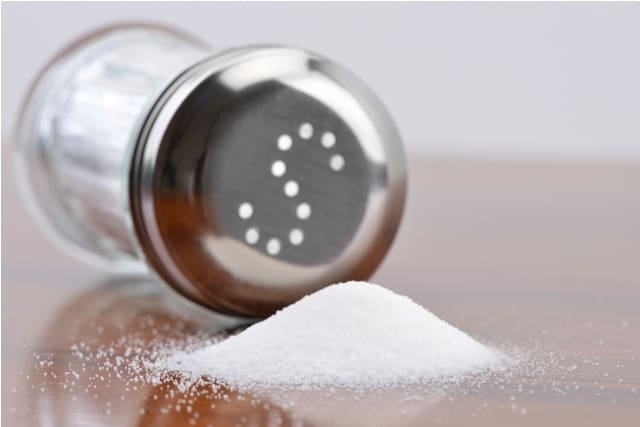While it’s true that we need sodium for vital bodily functions, most of us are in no danger of coming up short in the sodium department. And actually, it’s not because we are loading up on salt in the foods we are making at home.

A study published this year examined the diets of adults from three different geographic regions of the U.S. and found that sodium added to food outside the home was the leading source, accounting for about 70% of total sodium intake. And, although the amount varied in some subgroups of the study sample, it was still the leading contributor for all groups. (Only about 10% came from salt added at the table or during cooking at home.) This finding matches well with public health recommendations to reduce sodium intake from take-out, convenience and restaurant foods as a primary strategy to decrease sodium intake in the U.S.
So no, Virginia, it’s not the sodium you’re shaking onto your eggs in the morning that’s bumping your sodium intake sky high—it’s the deli sandwich you got for lunch (with chips) and the take-out pizza you brought home for dinner. It’s the drive-through fries, the prepared rotisserie chicken from the corner store and the nachos at happy hour on Friday that are making up a big portion of your sodium intake. (And aside from that, the breads, crackers, pasta sauce, soup and crispy snacks we buy push that number up even further.) Americans consume an average of 3,400 mg of sodium per day—about 50% more than the 2,300mg limit recommended by health authorities. But what if we made some of these items at home?
There’s no shortage of recipes for restaurant “taste alike” dishes on the internet, and chances are, they’ll contain less sodium per serving than their restaurant counterparts. Certainly, cooking at home is a sodium-saver, but what if you don’t want to make a complete lifestyle change? Here are some little, doable ideas for slashing sodium at home and away.
Switch up your sandwich fixings.
Nearly half of American adults eat at least one sandwich per day, according to a USDA study, which also found that sandwiches accounted for 30% of the recommended maximum daily sodium intake. What to do? First, broaden your horizons—maybe have a sandwich three times a week instead of 5 days a week, then cut back to two sandwiches a week. And if your heart is absolutely set on a sandwich, make an effort to purchase reduced-sodium meats, cheeses and condiments. Even better: use leftover home-cooked meat and poultry for your sandwich—turkey breast you cook at home will generally have less sodium than turkey lunch meat from the deli counter. Skip the cheese and pile on the veggies for interest and texture. Avoiding pickles and sliced olives will also help.
Watch out for key sodium words on menus.
Steer clear of menu items that include words like brined, smoked, barbecued, cured, or smoked—they tend to be more sodium-heavy than food items described as steamed, baked, grilled, poached or roasted. Ingredients like soy sauce, teriyaki sauce, miso, broth, and gravy or au jus also signal sodium.
Split your restaurant entrée with your dining companion.
Or ask for a to-go box at the same time that you order your food (box up the half portion and set it aside before you start eating). This automatically cuts your sodium and calorie intake in half—a bonus! Serving smaller portions at home is a smart idea, too, and you can bulk up the rest of your plate with extra veggies.
Make a habit to taste your food before salting it.
It seems obvious, but lots of people do not taste their food before seasoning it at the table. If you do want to add some salt, sprinkle the salt into your open palm—it’s easier to see how much has come out of the salt shaker that way. You can also skip the salt and instead season with pepper or a squeeze of fresh lemon or lime for extra zing.